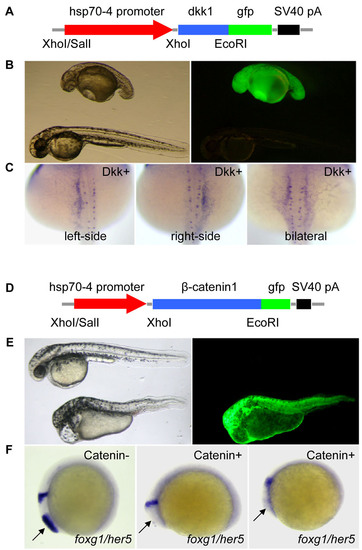Fig. S1
- ID
- ZDB-FIG-120131-25
- Publication
- Caron et al., 2012 - Wnt/?-catenin signaling directly regulates Foxj1 expression and ciliogenesis in zebrafish Kupffer?s vesicle
- Other Figures
- All Figure Page
- Back to All Figure Page
|
Generation of functional Tg(hsp:dkk1-GFP) and Tg(hsp:β-catenin-GFP) transgenic fish. (A) Schematic of hsp70 promoter-driven dkk1 expression. An upstream sequence (<1.6 kb) of zebrafish hsp70-4 (Halloran et al., 2000) and full-length zebrafish dkk1 encoding sequence were inserted in-frame into the tol2 GFP vector. The resulting plasmid was co-injected with tol2 transposase RNA into one-cell staged embryos. (B) The fused GFP tag allows discrimination of Dkk1-expressing embryos (GFP+) from non-transgenic siblings (GFP-) after heat-shock treatment. Transgenic Dkk1 embryos that were heat activated at 30% epiboly had tail/trunk truncation, a characteristic phenotype of loss of Wnt signaling (Lekven et al., 2001). Heat-shocked non-transgenic siblings exhibited normal morphology. (C) Representative images of pitx2 expression in transgenic Dkk1 embryos (Dkk+) heat-shocked at the bud stage. Shown are dorsal views of 22-somite staged embryos. Normal left-sided expression became randomized. (D) Schematic of hsp70 promoter-driven β-catenin1 expression. An upstream sequence (<1.6 kb) of zebrafish hsp70-4 (Halloran et al., 2000) and full-length zebrafish β-catenin1 encoding sequence were inserted in-frame into the tol2 GFP vector. (E) Transgenic β-catenin1 embryos activated at the sphere stage had anterior head truncation, a characteristic phenotype of gain of Wnt signaling (Lekven et al., 2001). (F) Induction of β-catenin1 (Catenin+) at the sphere stage abolished the expression of forebrain marker foxg1 but maintained the expression of midbrain-hindbrain boundary marker her5 compared with heat-shocked non-transgenic siblings (Catenin-). Arrows indicate foxg1 expression. |

